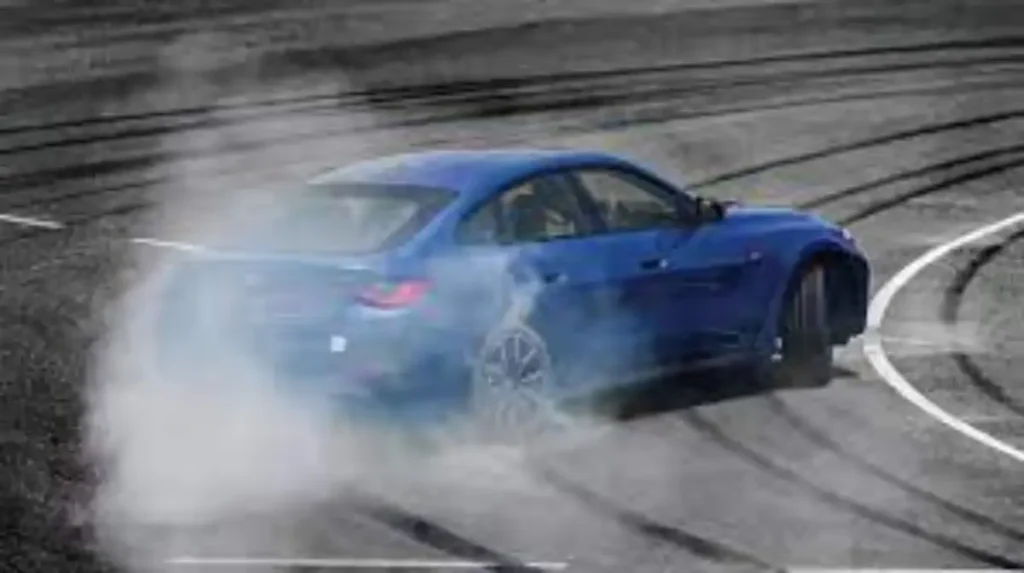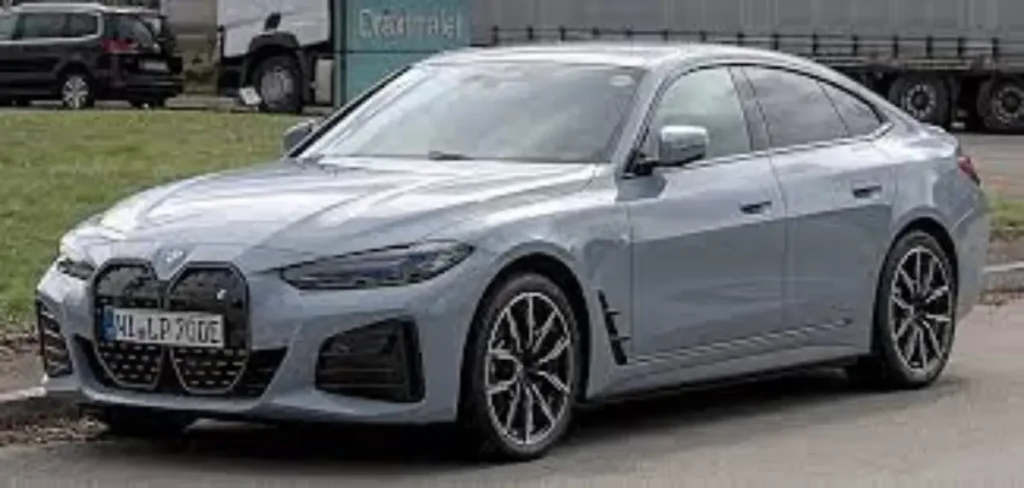BMW i4 :The June 2022 issue of Autocar India magazine featured a first look preview of the highly intriguing all-electric BMW i4, which concluded with the phrase “to be continued.” The i4 has the traditional BMW i4 components of a low, slung form, a powerful motor, and rear-wheel drive, but a thorough drive is necessary to render a judgement. I can share the good news with you now that I’ve driven it.
Initially, a quick summary of the car’s primary features. The BMW i4 is the all-electric version of the 4 Series Gran Coupe, which is a four-door coupe version of the well-known 3 Series and is not available for purchase in India. The i4 is available in India with an eDrive40 motor mounted at the back that powers the back wheels. A strong 340 horsepower and 430 Nm are produced by this electrically excited synchronous motor, allowing for a claimed 5.7-second 0-100 kph time. An 83.9kWh lithium-ion battery pack under the floor provides power for the motor. The highest range of EVs currently available for purchase in India is 590 km, made possible by the aforementioned battery pack on the WLTP cycle. Talk about driving feel now.
BMW i4: driving and performance

Naturally, the first thing that strikes you about an i4 is its lack of sound. A synthesised note on “ignition” informs you that everything is operational; aside from that, the i4’s interior is so silent that it sounds like a 320d. You won’t hear much outside noise while driving; the only sound you’ll hear is tyre noise. Not only is it quiet, but its smooth power development, comfortable steering weight, and precisely calibrated regen braking all contribute to a peaceful driving experience. With B mode (which is selectable with the gear lever), you can unlock the strongest retardation and single-pedal driving by alternating between the various levels of regen. My attention is also drawn to ride comfort.
While You Care for Your Car, Care for Your Child’s Future Too 💖
A fun and educational book every parent should gift their kid.
 Get Kiddy Store Fortune Now
Get Kiddy Store Fortune Now
The tyres skillfully smooth out any bumps, and the damping is expertly calibrated. The problem is that my route has large speed breakers and broken stretches that require careful manoeuvring because there is only 125mm of ground clearance, which is comparable to that of a sportscar. The rear axle air suspension of the i4 is adjustable, but ride height is not.
The i4’s sporty side is on display on the deserted, winding stretch of road outside the city limits. Dabs of accelerator produce an EV-typical instant response, but the fact that all of the power feels usable is what makes it easier to get into a rhythm with the vehicle. It’s good that the i4 eDrive40 isn’t overpowered. The throttle response has a natural progression, and you’ll notice that the i4 only performs at its peak when required. But don’t let that fool you—the i4 is quick and has thrilling, ready power.
The i4 handles like a BMW should, which is another satisfying conclusion. Considering that it weighs 500 kg more than a 330i, my concerns were not unjustified. Although it lacks the sharpness of BMW’s best, the i4 still feels nimble, turns into turns with precision, and conceals its weight well around turns. The i4 has a lower centre of gravity than a 3 Series due in part to the heavy battery’s low position.
The steering has excellent feel and connection, and experienced drivers will particularly enjoy the on-throttle adjustability that only rear-wheel drive provides. You can also customise the experience to your preferences with the regen, steering, and motor modes. Not only is the i4 an enjoyable electric vehicle to drive. Driving is enjoyable. Clearly.
BMW i4: exterior
Other than that, there aren’t many differences between the BMW i4 and its combustion engine counterpart. This is mostly because the i4 is not constructed on an architecture specifically meant for EV skateboards, but rather on the same platform. Thus, this isn’t your space-efficient, cab forward gawky look. Frameless windows, a high deck boot, and a flowing roofline add glitz to this traditional long-bonneted BMW sedan. The optional M Performance kit, which adds stylish bumpers and more eye-catching 18-inch rims (standard 17-inch rims) further adorns our test vehicle.

The oversized kidney grille, which draws attention to the bucktoothed look up front, is aggressive and shouty, but it looks better in person than in pictures. Yes, to a certain degree. Photos don’t show how much of the grille is closed off, and the bottom flaps are in an active state. Depending on the needs for cooling the engine and batteries, these flaps open in ten stages.
BMW i4: interior and features
Subtle indicators that this is an electric vehicle (EV) include the blue surround for the BMW emblem on the steering wheel, a blue-colored start button, and blue accents on the gear lever. However, the overall impression is that of a modernised 3 Series. The interior of the 2023 3 Series facelift is actually hinted at by the i4. The most notable modification is the BMW Curved Display, which consists of a 14.9-inch central touchscreen that integrates with 12.3-inch digital dials. The interior has a very modern feel to it because of the free-standing screens and single-piece design.

The touchscreen is iPad-like in its resolution and responses, and there’s a rotary controller too for easy access. What’s an irritant is that physical buttons for the climate control have been done away with and all settings are via the screen. You could try your luck with the voice assistant, but the system often trips on Indian accents. The digital dials that change theme with driving modes are vibrant, and what’s nice is that the high-contrast display is legible even under direct sunlight.
As one might expect, the cabin quality is excellent, and the open-pore wood accents and synthetic leather upholstery add a cosy feel to the interior. Additionally, the front sport seats provide all the necessary support.
When you give the back seat adequate weight, the i4’s case weakens. The rear part of the cabin is best described as cosy because of the high centre tunnel (a remnant of the ICE platform) and low roofline. Although there is plenty of knee room, the battery pack’s underfloor location forces the user to adopt a knees-up position. A spare tyre would take up most of the usable space here, but the powered rear hatch lifts to reveal a respectable 470 litres of space.
LED headlights, ambient lighting, a sunroof, three-zone climate control, powered steering, powered seats with driver seat memory, a 17-speaker Harmon Kardon sound system, and a reversing assistant are among the features of the i4. Both keyless entry and a 360-degree camera are absent. Although the i4 lacks ADAS features in India, the body shell of the BMW was deemed stable during crash tests conducted by Euro NCAP, earning the car a 4-star rating.
BMW i4: price and verdict
There are several methods for charging the i4’s battery pack, but most owners will probably prefer to use the 11kW AC wallbox that comes with the vehicle (0 to 100 percent takes 8.5 hours). Although the i4 can be charged at up to 205kW, Indian owners will soon need to use the more widely used 25kW DC chargers. The problem is that, with a claimed 590 km WLTP range and a real-world range of up to 400 km, long-distance drives would be the only occasions on which dedicated stops to charge would be made.
One of the many appeals of the i4 is how easily it can be incorporated into your daily routine. The price tag, however, is what draws people in the most. The price of Rs 69.9 lakh (ex-showroom, India) places the i4 in the same range as the more expensive 5 Series and the sporty M340i. A lot of people will undoubtedly go crazy for the strong, entertaining, and fashionable i4 at a time when green licence plates are popular.
BMW i4 Review on You-Tube
Also Read: Take Your Workout to the Next Level with the Hero Xoom: A Sporty Review

